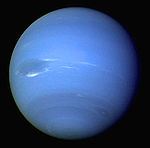- Psamathe (moon)
-
Psamathe 
Discovery [1][2] Discovered by Discovered 2003 Mean Orbital elements [3] Epoch June 10, 2003 Semi-major axis 48.096 Gm Eccentricity 0.3809 Inclination 126.312° * Orbital period 9074.30 d
(24.84 a)Physical characteristics Mean diameter 38 km[4][5] ** Albedo 0.04 assumed[4] *to the ecliptic **based on the albedo Psamathe (
 /ˈsæməθiː/ sam-ə-thee; Latin: Psamathē; Greek: Ψαμάθη), also known as Neptune X, is a retrograde irregular satellite of Neptune. It is named after Psamathe, one of the Nereids. This moon was discovered by Scott S. Sheppard and David C. Jewitt in 2003 using the 8.2 meter Subaru telescope.[4] Before the announcement of its name on February 3, 2007 (IAUC 8802), it was known by the provisional designation S/2003 N 1.[6]
/ˈsæməθiː/ sam-ə-thee; Latin: Psamathē; Greek: Ψαμάθη), also known as Neptune X, is a retrograde irregular satellite of Neptune. It is named after Psamathe, one of the Nereids. This moon was discovered by Scott S. Sheppard and David C. Jewitt in 2003 using the 8.2 meter Subaru telescope.[4] Before the announcement of its name on February 3, 2007 (IAUC 8802), it was known by the provisional designation S/2003 N 1.[6]This moon is about 38 kilometers in diameter. It orbits Neptune at a distance of about 46,695,000 km and requires almost 25 Earth years to make one orbit. The orbit of this satellite is close to the theoretical stable separation from Neptune for a body in a retrograde orbit. Given the similarity of this moon's orbital parameters with Neso (S/2002 N 4), it was suggested that both irregular satellites could have a common origin in the break-up of a larger moon.[4] Both are further from their primary than any other known moon in the Solar System.[7]
See also
- Irregular satellites
References
- ^ JPL (2011-07-21). "Planetary Satellite Discovery Circumstances". Jet Propulsion Laboratory. http://ssd.jpl.nasa.gov/?sat_discovery. Retrieved 2011-10-24.
- ^ Green, Daniel W. E. (September 3, 2003). "Satellites of Neptune". IAU Circular 8193. http://www.cbat.eps.harvard.edu/iauc/08100/08193.html. Retrieved 2011-10-24.
- ^ Jacobson, R. A. (2008). "NEP078 - JPL satellite ephemeris". Planetary Satellite Mean Orbital Parameters. http://ssd.jpl.nasa.gov/?sat_elem. Retrieved 2009-09-23.
- ^ a b c d Sheppard, Scott S.; Jewitt, David C.; Kleyna, Jan (2006). "A Survey for "Normal" Irregular Satellites around Neptune: Limits to Completeness". The Astronomical Journal 132: 171–176. arXiv:astro-ph/0604552. Bibcode 2006AJ....132..171S. doi:10.1086/504799.
- ^ Sheppard, Scott S.. "Neptune's Known Satellites". Department of Terrestrial Magnetism (Carnegie Institution of Washington). http://www.dtm.ciw.edu/users/sheppard/satellites/nepsatdata.html. Retrieved 2008-12-13.
- ^ Marsden, Brian G. (2003). "MPEC 2003-R19 : S/2003 N 1". Minor Planet Center, Smithsonian Astrophysical Observatory. http://www.minorplanetcenter.org/mpec/K03/K03R19.html. Retrieved 2011-01-08.
- ^ Schmude, Richard, Jr. (2008). Uranus, Neptune, Pluto and How to Observe Them. Springer. p. 106. ISBN 0387766014.
External links
- Neptune's Known Satellites (by Scott S. Sheppard)
- S/2003 N1 Neptune Satellite Movie Images (image)
- MPC: Natural Satellites Ephemeris Service
- Mean orbital parameters (NASA)
- IAUC 8193
Moons of Neptune Generally listed in increasing distance from NeptuneRegular (inner) Triton Irregular See also Neptune Discovery 
Characteristics - Rings
- Great Dark Spot
- Small Dark Spot
- The Scooter
- Kuiper belt
Moons Exploration Trojans Miscellaneous Categories:- Moons of Neptune
- Irregular satellites
Wikimedia Foundation. 2010.
